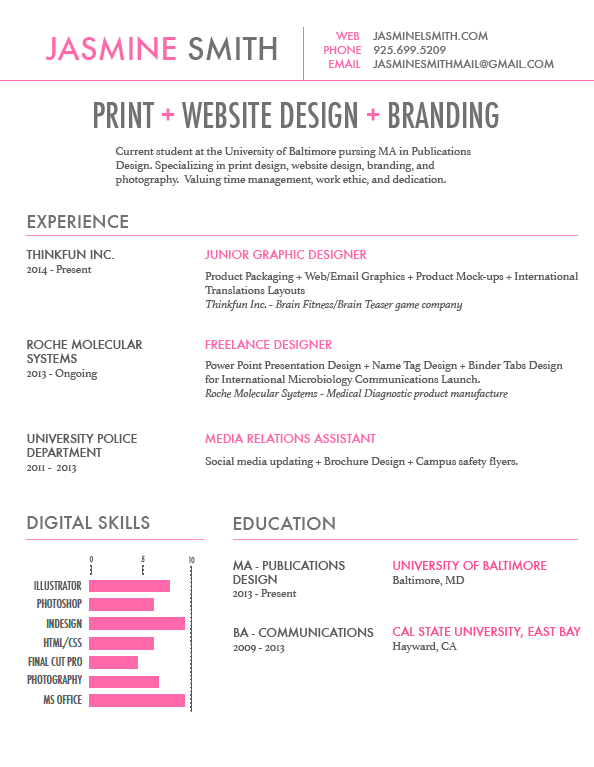My resume is completely out of date, and I haven't even worked on one that's specific to design positions, so take this with that grain of salt. I think both the resume and the portfolio are important for different reasons, and depending on what kind of position you're applying for (watch out, as this will become a theme, I believe).
If the position is a permanent position within a company, design or otherwise, the resume might be more important than if the position is freelance. Granted, this is entirely anecdotal on my part, but I get the impression that online portfolios and word-of-mouth/networking can drive more contacts for freelance work. With a permanent position in an organization or company, the resume seems more important since that (and don't forget cover letters/emails!) will be the first impression you make with the hiring manager. So, my post is pretty much entirely about resumes.
Ultimately, though, for me, what's included in a resume (and cover letter) and how it looks DEPENDS. It depends on the position. It depends on the company you're applying to. It depends on you doing your research about them. It depends on your being able to show them that you can give them what they want, or what they need, and that you can do that efficiently. You can't just have one resume that you send for all design jobs. Every time I've applied for positions, I've edited my resume and my cover letter for each position with each organization/company/school. I'll have a default for each type of position, saved as something like "JenniferTaylor_Resume_Communications" and "JenniferTaylor_Resume_Teaching," but then I tweak that template for each job, paying close attention to the language in each different opening's description.
As cool as the resume designs that you linked to look, Monique, I'd be wary of going too far into that "ultra-designed" look for a resume. If you want your portfolio and business cards/identity to be super cool, that's fine, but with resumes, I'd err on the side of being a bit more straightforward, and here's why: there's not always a person deciding which resumes will earn a call/interview. Sometimes it's a computer program scanning for key words; that's probably not an issue for smaller design or creative groups, but the larger the employer, the more likely the system is automated in some way. Even if it's a person deciding, though, there's the statistic that employers look at your resume for about seven seconds before they decide whether to throw it away or not; no matter the job, the resume needs to be easy to scan. I'm not sure all of those 50 qualify as easy to scan.
Also, I'm curious when this [the hongkiat list] was posted (I can't find a date for it, which is problematic with something online for me) because it seems like the infographic-style resume hit a peak about two years or so ago and has lost some of its appeal. How does a hiring manager know what it means that Zhi Liang has 5 pencils worth of skill at InDesign? The ones on here that I find useful are those that seem more personalized, that show something of the designer's aesthetic and/or personality, but for all of them, I'm curious--these are linked to behance sites, so did any of these get the designer a job/position/contract? Read: I'm skeptical.
Here's a post from Forbes.com in which three hiring managers and heads in advertising, branding and design talk about whether creative resumes get people jobs/interviews at their firms; this is from 2012 so maybe it's outdated, but I think most of it still applies. So whether a creative resume is working DEPENDS. Again, ultimately, I think your resume should be what works for you and for the company you're aiming for:
I'm also skeptical because as tastes have changed, so have templates.
This company will sell you a slick designy resume template as a .psd or an InDesign file. Do you want to see the "
41 Best Resume Templates Ever"? Well, The Muse has them for you. Presumably, hiring managers have the same Google that I do, so they can see these, as well. Again, ultimately, the resume is about content more than design; of course it's an opportunity to show what you can do, but I think it's more important to show that you're aware that they're looking at hundreds of these so you want their experience to be quick and easy through clean, organized, well-thought-out, typographically sound design.
Here are some resume-related links that I find helpful:
AIGA: Ten Common Mistakes in Resumes and Cover Letters
An Editor's Guide to Perfecting your Resume
And the previously-mentioned Forbes post,
Will a Graphic Resume Get You the Job? The Experts Respond
Another thing to consider: a friend of mine who has a job and wasn't actively looking for one (though this is in a different field than communications/design) was recently recruited into a search for a position through LinkedIn. While I think LinkedIn is generally a good site to be on professionally, there are also other sites like Behance, dribbble, Coroflot, and
Talent Zoo that cater to communications- or design-related fields. I'm always curious how effective those might be for connecting people who are hiring to people with the skills they need.











